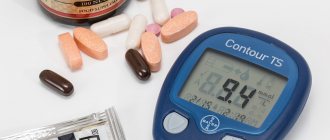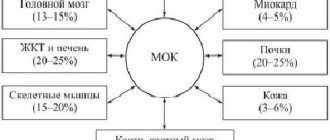Accelerated ESR syndrome causes
ESR is a nonspecific blood indicator that shows the ratio of plasma protein fractions. Under the influence of coagulants, the blood is deprived of the ability to clot and the rate of erythrocyte sedimentation under the influence of gravity is observed.
Sometimes, over the course of many years, a person experiences an increased erythrocyte sedimentation reaction, the so-called accelerated ESR syndrome.
Factors influencing ESR
ESR depends on the protein composition of the blood and the electrical properties of red blood cells and is determined by the degree of their aggregation. Red blood cells normally repel each other and do not stick together because they are negatively charged.
The level of aggregation (and therefore ESR) increases with an increase in acute phase proteins in the blood plasma - fibrinogen, immunoglobulins, ceruplasmin, CRP, etc. These are markers of the inflammatory process.
Reasons for ESR acceleration
- inflammatory processes (with purulent ones, the ESR is especially increased);
- tumors;
- autoimmune diseases (rheumatism, rheumatoid arthritis);
- infectious diseases;
- thrombosis;
- metabolic diseases;
- cirrhosis of the liver.
Factors leading to an increase in ESR
When drawing up a doctor's conclusion, it is necessary to take into account a number of factors in which the ESR increases.
- pregnancy;
- elderly age;
- female;
- anemia;
- renal failure;
- hypercholesterolemia;
- an increase in the blood concentration of all proteins except fibrinogen;
- heparin;
- severe obesity (extreme).
The ESR indicator changes over time, so dynamics are important. ESR increases as the ongoing pathological processes become more severe. Accelerated erythrocyte sedimentation in values of 40-50 mm/hour is a good reason for examining the whole body.
Why does level up occur?
The reasons for increased ESR may be different, but there are a number of diseases in which this situation occurs. Among them:
- leukemia and other blood pathologies;
- cerebral hemorrhage, stroke;
- diabetes, obesity and other diseases related to metabolic disorders;
- liver and gallbladder disease;
- tuberculosis;
- cancerous tumors.
Also, ESR is higher than normal when there is an inflammatory process in the human body or the presence of infectious diseases is noted. Since a child’s body is different from an adult’s, the ESR standards are different.
Against the backdrop of high indicators, a child feels much worse than an adult. Loss of appetite, feeling drowsy, etc. Although an increased result can be achieved by taking an antipyretic the day before, which contains paracetamol, or by the appearance of worms.
Each person is recommended to undergo a systematic health check, including simple laboratory tests, which include the determination of ESR. If an increased result is detected for no reason, you need to take a second test after some time.
Important information: Norm of red blood cells in children by age (table)
What is the danger of deviation
There are a number of diseases that occur in the body in a latent form (oncology, latent form of tuberculosis, pneumonia), and additional laboratory tests will help identify the disease at an early stage.
Indicators are normal depending on the age and gender of patients
The normal ESR indicators directly depend on the age and gender of the patient. On average, standard indicators of erythrocyte sedimentation rate are:
- Newborns: 1-2 mm/hour. Deviations of these indicators are rare and, as a rule, indicate low protein concentration, hypercholesterolemia or acidosis.
- Until six months of age, ESR values in children fluctuate between 12-17 mm/hour.
- In older children, ESR levels drop, and 1-8 mm/hour is considered normal.
- For an adult male, the normal ESR is more than 10 mm/hour.
- For representatives of the fair sex, indicators can be scattered between 2 and 15 mm/hour. This variation is due to changes in the hormonal balance of the female body. Depending on the period, age and state of life of a woman, ESR indicators can vary significantly. For example, in the second trimester of pregnancy, the erythrocyte sedimentation rate increases and by birth it may already be 55 mm/hour, which is also considered normal.
After delivery, blood counts return to normal values. The increase in ESR during pregnancy is explained by increased blood volumes, as well as globulins, cholesterol and a reduced amount of calcium.
Symptoms of type 1 diabetes
The disease usually begins suddenly and has the characteristic clinical symptoms of type 1 diabetes:
- Frequent trips to the toilet “in small ways” (polyuria), which is facilitated by an increase in the osmotic pressure of urine due to the presence of glucose in the urine, which normally should not be there. Diabetes in children occurs with bedwetting.
- Severe thirst (polydipsia) occurs due to the loss of large amounts of fluid in the urine, and with increased appetite, rapid weight loss occurs;
- The patient is concerned about dry mouth, itchy skin, and fatigue;
- Frequent pustular skin diseases (boils, carbuncles) are considered nonspecific signs.
But even these clear signs of diabetes are not always considered by the patient as a disease. Underestimation of the situation often occurs in children. Then a visit to the doctor is carried out only when complications develop, which do not take long to occur. Within a few weeks, ketoacidosis may develop - an increase in ketone bodies and glucose in the blood. The patient smells of acetone. The condition requires immediate hospitalization. If left untreated, the condition can progress to a diabetic coma.
Diabetic coma is a consequence of hyperglycemia and the accumulation of ketone bodies; as a result of a lack of insulin, tissue starvation occurs, since glucose in its absence is not absorbed by many organs.
Infectious diseases
Accelerated ESR syndrome (according to ICD-10 R70) is also observed in diseases of an infectious nature, including tonsillitis, otitis and sinusitis, pathologies of the genitourinary and respiratory systems, as well as sepsis and meningitis.
Early diagnosis makes it possible to identify pathology and study its pathogenesis. This helps to prescribe effective treatment and prevent complications and consequences. There are also cases when the erythrocyte sedimentation rate increases for no apparent reason.
General information
The term "diabetes" comes from the Greek language and means "flowing, flowing out", so the name of the disease describes one of its key symptoms - polyuria, the passage of large amounts of urine. Type 1 diabetes is also called autoimmune, insulin-dependent and juvenile. The disease can manifest at any age, but more often manifests itself in children and adolescents. In recent decades, there has been an increase in epidemiological indicators. The prevalence of all forms of diabetes mellitus is 1-9%; the insulin-dependent variant of the pathology accounts for 5-10% of cases. The incidence depends on the ethnicity of the patients, and is highest among Scandinavian peoples.
Differential diagnosis for this pathology
Before concluding that a deviation in indicators is a safe phenomenon for the patient, a specialist must conduct a differential diagnosis of accelerated ESR syndrome and the following diseases:
- Pathologies of viral, bacterial and infectious origin.
- Inflammatory processes of a systemic or local nature.
- Malignant neoplasms.
- Rheumatic diseases and other autoimmune conditions.
- Diseases manifested by necrotic processes in tissues, such as tuberculosis, cerebral stroke, myocardial infarction, etc.
- Blood diseases, including anemia.
- Injuries, intoxication, prolonged stress.
- Disruption of metabolic processes in the body, for example, with diabetes.
Living with type 1 diabetes
The main thing to remember when reading the diagnosis is to under no circumstances fall into panic or depression. SD is not a death sentence. Panic or depression leads to rapid development of complications.
If you follow all the rules, you can live a long and happy life as a healthy person. These measures are the most adequate, because they help ensure a normal life for the patient. There are many cases where a person has lived with T1D for decades.
Today there is more than one person on earth who is successfully fighting this disease. According to media reports, there is a diabetic in the world who recently celebrated his 90th birthday. He was diagnosed with type 1 diabetes at the age of 5. Since then, he began to closely monitor the level of glucose in his body and constantly underwent all the necessary procedures.
Additional studies for this deviation
Accelerated ESR syndrome may indicate an existing pathology or an incipient disease in the body. If an abnormality is detected in the analysis results, a repeat blood test is performed to confirm the results. If the results match, the patient is prescribed a more detailed examination, which will include a detailed history, x-rays, blood tests, ECG, ultrasound, palpation of organs and other diagnostic methods. If the ESR has accelerated due to the disease, then eliminating the cause of the deviation will bring the blood counts back to normal.
We looked at how such a pathology as accelerated ESR syndrome manifests itself.
Pathogenesis
The pathology is based on insufficient production of the hormone insulin in the beta cells of the islets of Langerhans of the pancreas. Insulin-dependent tissues include liver, fat and muscle. When insulin secretion decreases, they stop taking glucose from the blood. A state of hyperglycemia occurs - a key sign of diabetes mellitus. The blood thickens, blood flow in the vessels is disrupted, which is manifested by deterioration of vision and trophic lesions of the extremities.
Insulin deficiency stimulates the breakdown of fats and proteins. They enter the bloodstream and are then metabolized by the liver into ketones, which become energy sources for non-insulin-dependent tissues, including brain tissue. When the blood sugar concentration exceeds 7-10 mmol/l, the alternate pathway for glucose excretion is activated - through the kidneys. Glucosuria and polyuria develop, as a result of which the risk of dehydration of the body and electrolyte deficiency increases. To compensate for the loss of water, the feeling of thirst increases (polydipsia).
How is accelerated SES syndrome treated?
When health is normal, but ESR levels are off the charts, this means that a person has accelerated ESR syndrome.
The erythrocyte sedimentation rate is determined using several methods - Westergren and Panchenkov. In the first case, blood from a vein is studied in a special two-hundred-millimeter tube, and for the second, capillary blood from a finger is required. It is diluted in a solution with sodium citrate in a glass capillary.
If high ESR values are detected without abnormalities in other tests, differential diagnosis may be prescribed. It will help to accurately determine the diagnosis and indicate whether the increase in speed really indicates a specific disease or is an individual norm.
Causes of accelerated ESR syndrome:
- Absence of reasons (this is the most likely scenario).
- The following diseases: cystitis, pneumonia, malignant tumor, sinusitis, viral hepatitis, bronchitis, tuberculosis, pyelonephritis.
In addition, an increase in ESR is stimulated by diseases such as meningitis, sepsis, infections of the genitourinary system and/or respiratory tract, tonsillitis, sinusitis, and otitis media.
Additional causes of the syndrome may be:
- Advanced age.
- The period of breastfeeding a child.
- Sudden weight loss.
- Excessive saturation of blood plasma proteins.
- Mistakes made during diagnosis.
- Use of hormonal drugs.
- Anemia of all types.
- Blood oversaturated with cholesterol.
- Pregnancy.
The syndrome often has no symptoms - neither pronounced nor mild. Its presence can only be determined from the analysis result.
Most often, such an anomaly is discovered by chance, during a routine or preventive medical examination. Usually, after the analysis confirms the presence of accelerated ESR syndrome in the body, no treatment is prescribed. Before confirming the diagnosis, a complete check of the entire body is carried out, and if it does not show any abnormalities, it is considered as normal for a particular patient. Sometimes an additional test may be prescribed to make sure that everything is in order with the body, and only the ESR is abnormally high.
In children, high ESR levels are often not considered as a deviation from the norm. But if other indicators have deviations, then in this case the doctor either makes an appropriate diagnosis or suggests taking other tests.
However, this does not mean that such indicators can be forgotten. It is highly recommended that if the ESR is increased, you should be observed by your doctor for some time in order to promptly identify the incipient disease. If you follow all medical recommendations, then in almost all such cases a positive outcome is predicted.
Preparation for the procedure and blood sampling
Indications for determining ESR are monitoring the appearance and intensity of the inflammatory process in various diseases and their prevention. Deviations from the norm indicate the need for a biochemical blood test to clarify the level of certain proteins. It is impossible to make a specific diagnosis based on ESR testing alone.
The analysis takes from 5 to 10 minutes. Before donating blood to determine ESR, you should not eat for 4 hours. This concludes the preparation for donating blood.
Sequence of capillary blood sampling:
The third or fourth finger of the left hand is wiped with alcohol.
A shallow incision (2-3 mm) is made on the fingertip with a special tool.
Remove any drop of blood that appears with a sterile napkin.
Biomaterial is collected.
Disinfect the puncture site.
Apply a cotton swab soaked in ether to the fingertip and ask to press the finger against the palm to stop the bleeding as quickly as possible.
Sequence of venous blood sampling:
The patient's forearm is tied with a rubber band.
The puncture site is disinfected with alcohol, and a needle is inserted into the vein of the elbow.
Collect the required amount of blood in a test tube.
Remove the needle from the vein.
The puncture site is disinfected with cotton wool and alcohol.
The arm is bent at the elbow until the bleeding stops.
Blood taken for analysis is examined to determine ESR.
How is accelerated ESR syndrome treated?
The indicators become stable if a course of treatment for the current illness is carried out. There is also a very high probability that the ESR itself decreases to an acceptable norm, for example, after the birth of a child or wound healing (these are considered as potential catalysts for the syndrome).
Pregnant women need to adhere to the course of treatment developed by their doctor. A good addition to this would be a special diet that will eliminate the risk of anemia.
A decrease in indicators is possible only after the source of inflammation disappears. The syndrome may subsequently signal the onset of a rather serious disease. If such a syndrome is ignored, then the likelihood of cancer, heart disease, pneumonia, and tuberculosis increases many times over.
To find out whether the syndrome is indeed a precipitating factor for the above diseases, your doctor may recommend a C-reactive protein test. It helps to finally clarify whether an elevated ESR is normal for a particular person or whether it is the cause of potentially serious illnesses.
Materials used in the article:
https://allmednews.ru/sindrom-yskorennogo-soe-simptomy-prichiny-diagnostika/
https://obanalizekrovi.ru/sostav-i-svojstva/soe/kak-lechitsya-sindrom-uskorennogo-seo.html
https://radavam60.ru/pochemu-postojanno-hochetsja-spat/
Post Views: 156
Complications
Prolonged disruption of carbohydrate metabolism can lead to diabetic ketoacidosis, a condition characterized by the accumulation of ketones and glucose in the plasma and increased blood acidity. It occurs acutely: appetite disappears, nausea and vomiting, abdominal pain, and the smell of acetone in the exhaled air appear. In the absence of medical care, confusion, coma and death occur. Patients with signs of ketoacidosis require urgent treatment. Other dangerous complications of diabetes include hyperosmolar coma, hypoglycemic coma (with improper use of insulin), “diabetic foot” with the risk of limb amputation, severe retinopathy with complete loss of vision.
Need to know about diabetes
Type 1 diabetes mellitus is an incurable form of the disease. Diabetes of this type mainly begins to develop at a young age, in contrast to type 2. With this type of diabetes, people begin to destroy beta cells in the pancreas, which are responsible for producing insulin. Complete destruction of these cells leads to insufficient insulin in the blood. This leads to problems converting sugar into energy. The main symptoms of type 1 diabetes:
- Severe weight loss;
- Increased urination;
- Constant feeling of hunger;
- Thirst;











